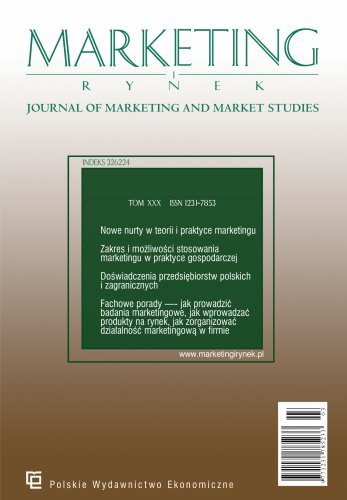New concepts in marketing, comparative analysis – Marketing Technology and MarTech
In the technological environment, new tools and technical solutions appear, which are increasingly used by companies conducting marketing activities. Both the tools themselves and the ways of using them in marketing generate new names and terms, supplying the increasingly growing areas referred to as: Marketing Technology or MarTech. These concepts have many common parts and at the same time they have areas and uses that are clearly distinguishing them from each other. The multitude of new names and their various definitions can easily introduce conceptual chaos, which makes it difficult to conduct discourse and scientific research in the area of using modern technologies in marketing. Therefore, it seems important to search for the current definition and publication context of these terms. For this purpose, the authors conducted two quantitative analyses: a bibliometric analysis of scientific publications and an analysis of a set of information obtained from the Internet known as big data. The first analysis was carried out in 261 scientific publications with the term Marketing Technology and 62 publications with the term MarTech. For the second analysis, the refining method was used in over 2,600 sources and over 5,000 occurrences. As a result of both analyses, the authors identified common and separate areas of application of each of the concepts. Simultaneously, they also identified a increasing frequency of occurrence, both in scientific publications and in big data collections, of the concept of MarTech. The publication may be a starting point for further research and scientific analysis, the purpose of which will be to define specific areas and concepts in the field of technologies used in marketing.
References
Bibliografia/References
Alfonso, D. (2022). The Martech Handbbook Building a Technology Stack to Attract and Retain Customers. Kogan Page Limited.
Alford, P., & Page, S. J. (2015). Marketing technology for adoption by small business. Service Industries Journal, 35(11–12), 655–669. https://doi.org/10.1080/02642069.2015.1062884
Atasoy, H., Banker, R. D., & Pavlou, P. A. (2021). Information technology skills and labor market outcomes for workers. Information Systems Research, 32(2), 437–461. https://doi.org/10.1287/isre.2020.0975
Bloom, B., Brosnan, R., McCune, M., Boyes, A., & Mazumdar, A. (2022). Disruptions Derail Progress in Martech Utilization. Gartner. https://www.gartner.com/en/marketing/research/marketing-technology-survey-2022
Booth, D. (2019). Marketing analytics in the age of machine learning. Applied Marketing Analytics, 4(3), 214–221.
Brinker, S. (2022). Marketing Technology Landscape. ChiefMartec and MartechTribe. https://chiefmartec.com/2022/05/marketing-technologylandscape-2022-search-9932-solutions-on-martechmap-com/
Czakon, W. (2020). Podstawy metodologii badań w naukach o zarządzaniu (wyd. III rozszerz.). Wydawnictwo Nieoczywiste.
Donthu, N., Kumar, S., Mukherjee, D., Pandey, N., & Lim, W. M. (2021). How to conduct a bibliometric analysis: An overview and guidelines. Journal of Business Research, 133, 285–296. https://doi.org/10.1016/j.jbusres.2021.04.070
Glinka, B., & Czakon, W. (2021). Podstawy badań jakościowych. Polskie Wydawnictwo Ekonomiczne.
Gogołek, W., & Jaruga, D. (2016). Z badań nad systemem rafinacji sieciowej. Identyfikacja sentymentów. Studia Medioznawcze, 4(67), 103–111.
Gogołek, W., & Kuczma, P. (2013). Rafinacja informacji sieciowych na przykładzie wyborów parlamentarnych. Część 1. Blogi, fora, analiza sentymentów. Studia Medioznawcze, 2(53), 89–105.
Herhausen, D., Mioèević, D., Morgan, R. E., & Kleijnen, M. H. P. (2020). The digital marketing capabilities gap. Industrial Marketing Management, 90(October), 276–290. https://doi.org/10.1016/j.indmarman.2020.07.022
Hsu, C.-S., Islam, M., & Yang, Y.-F. (2016). Studies of CRM: Management capabilities and the mediating role of customer satisfaction. International Journal of Business Excellence, 10(2), 264–282. https://doi.org/10.1504/IJBEX.2016.078027
Kotler, P., Hermawan, K., & Iwan, S. (2021). Marketing 5.0. MT Biznes.
Kumar, V. (2018). Transformative marketing: The next 20 years. Journal of Marketing, 82(4), 1–12. https://doi.org/10.1509/jm.82.41
Ma, L., & Sun, B. (2020). Machine learning and AI in marketing – Connecting computing power to human insights. International Journal of Research in Marketing, 37(3), 481–504. https://doi.org/10.1016/j.ijresmar.2020.04.005
Massimo, A., & Cuccurullo, C. (2017). Bibliometrix: An R-tool for comprehensive science mapping analysis. Journal of Informetrics, 11(4), 959–975. https://doi.org/10.1016/j.joi.2017.08.007
Neuhofer, B., Magnus, B., & Celuch, K. (2021). The impact of artificial intelligence on event experiences: A scenario technique approach. Electronic Markets, 31(3), 601–617. https://doi.org/10.1007/s12525-020-00433-4
Pritchard, A. (1969). Statistical Bibliography or Bibliometrics? Journal of Documentation, 25(4), 348–349.
Qin, H., Peak, D. A., & Prybutok, V. (2021). A virtual market in your pocket: How does mobile augmented reality (MAR) influence consumer decision making? Journal of Retailing and Consumer Services, 58, 102337. https://doi.org/10.1016/j.jretconser.2020.102337
Rach, M., & Scott, R. (2020). The use of virtual reality in marketing: Exploring the need for technology and language adaptation to create high quality immersive experiences. Smart Innovation, Systems and Technologies, 167, 67–77. https://doi.org/10.1007/978-981-15-1564-4_8
Rathnakar, G. (2019). Blockchain marketing through social media surges the economic growth of India. International Journal of Recent Technology and Engineering, 8(1 S4), 78–81.
Riemersma, F. (2021). Europa Marketing Technology Supergraphic 2021. MartechTribe. https://martechtribe.com/
Rogers, E. M. (2003). Diffusion of innovations (5th ed). Free Press.
Royle, J., & Laing, A. (2014). The digital marketing skills gap: Developing a digital marketer model for the communication industries. International Journal of Information Management, 34(2), 65–73. http://dx.doi.org/10.1016/j.ijinfomgt.2013.11.008
Woodcock, N., Green, A., & Starkey, M. (2011). Social CRM as a business strategy. Journal of Database Marketing and Customer Strategy Management, 18(1), 50–64. https://doi.org/10.1057/dbm.2011.7

